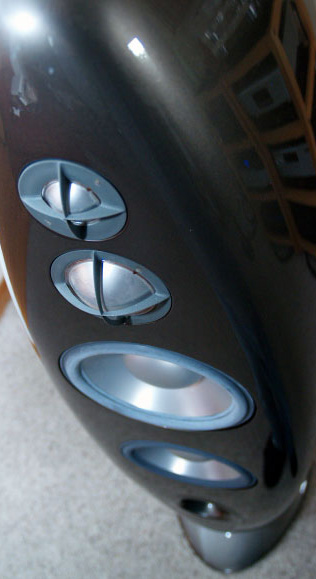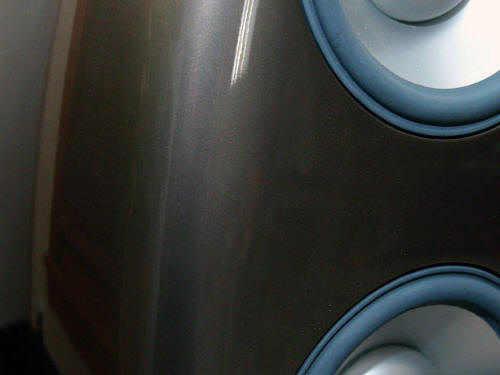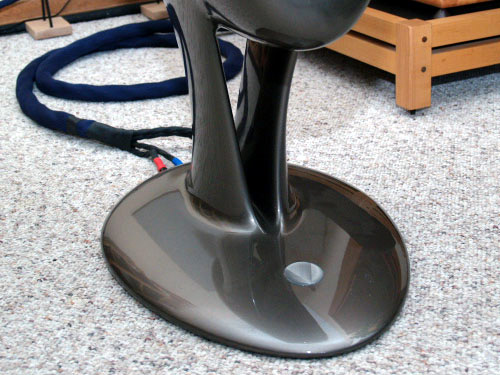You are reading the older HTML site
Positive Feedback ISSUE
january/february 2008
vivid audio
K1 loudspeakers
as reviewed by Mike Wechsberg

All images by Dave Clark.
|
MIKE WECHSBERG'S SYSTEM
LOUDSPEAKERS
ELECTRONICS
SOURCES
CABLES
|
Introduction
Sometimes PFO reviewers get lucky. My luck came from the opportunity to spend the holiday season with a wonderful pair of speakers from Vivid Audio, a company in South Africa; one that is relatively unknown here. "South Africa" you say. "What do they know about high-end audio way down there?” Well, quite a lot as it turns out. The speaker under consideration is the model K1 which, until recently, sat at the top of the Vivid line. The much larger Giya "statement speaker" was introduced at CES in January. All Vivid speakers are designed by Laurence Dickie who is notable for designing the very impressive-sounding Nautilus speaker from B&W some years back. Almost every part of the K1 has been custom developed by Vivid using sophisticated design tools, very detailed measuring and listening techniques, and state-of-the-art manufacturing methods. Most of the design work was done in the U.K. by the talented Mr. Dickie which is very unique and unusual. Some will recognize the similarities to the Nautilus speaker, but the Vivid K1 is a big step forward in both sophistication and sound.
Description
The Vivid K1 is a 3.5 way speaker that uses a total of six aluminum drivers. The two forward facing woofers are rigidly coupled to two identical rear facing woofers for "reaction canceling.” That is, the coupling ensures any forces from the front-facing woofers that would produce vibration in the enclosure is canceled by the rear-facing ones. This philosophy extends to the port.

Most ported speakers have a single opening (either facing to the front or the rear). The Vivid has two symmetrical ports opposite each other to cancel reactive forces. This configuration allows one to see completely through the speaker and contributes to its unique look. All the low frequency drivers receive the same signal below 100Hz (1st crossover), but as the frequency increases the response is rolled off such that only the top most front facing woofer is working at the next crossover at 900 Hz. The use of four 6-inch woofers in a ported enclosure give the speaker excellent low frequency extension flat to 40Hz, but there is audible port response down to 25Hz. Yet the woofers are small enough to be very fast for good transient behavior. The unique midrange and tweeter, also exclusive to Vivid Audio, employ aluminum diaphragms precisely formed into a special catenary shape to move the breakup modes well above the working range of each driver. The backwaves from both the midrange and tweeter work into exponentially tapered tubes that extend all the way to the back of the enclosure to damp out resonances and reflections. This is another variation on the Nautilus drivers. The final crossover, which employs a fourth order network, is at 4 kHz. All six drivers are decoupled from the enclosure by pliable O-rings to further guard against exciting cabinet resonances. There are no fasteners evident from the front of the enclosure creating for a clean look.

The enclosure for the Vivid K1 is very special, maniacally designed to eliminate resonances and diffraction effects. First, it's not made out of wood. Instead a very dense cast fiber reinforced polyester material is used (The Vivid Audio web site suggests some similarity to materials in the B2 bomber). Whereas almost anyone can set up shop to make wooden speaker cabinets, it takes quite a sophisticated operation to make precisely shaped and quite massive multilayer composite structures such as this enclosure. Using a cast material allows the cabinet design to take shapes unimaginable with wooden cabinets, and Mr. Dickie has taken full advantage of this flexibility. The K1 (and all but the most recent Vivid speaker designs) appears elliptical from the front and the enclosure is deep and tapered towards the rear. All surfaces are smooth and rounded and there are no parallel walls anywhere in the enclosure. Internal bracing is provided between the drivers. These features give the enclosure unusual rigidity to avoid cabinet resonances, and they ensure no sharp edges to produce diffraction or re-radiation to smear the time response. This extensive attention to the cabinet is executed to perfection and results in the very clean and tight sound I will talk about below. The version I tested had no grills but I understand all speakers imported to the U.S. will have metal grills. This is a good thing, as the aluminum drivers are extremely fragile and should not be touched. The nicely tapered base is an integral part of the enclosure, so one does not have to worry about purchasing a separate speaker stand. Electrical connections (bi-wiring is the preferred connection) are available at the rear foot of each speaker using high quality WBT connectors. All internal wiring is with Van den Hul cable.

Before addressing the sound of the K1 one has to deal with its looks first. Although quite beautiful this speaker won't be for everyone because of its radical appearance. One female friend said they look like alien beings. For me they sparked a recollection of the famous painting by Norwegian artist Edvard Munch called "The Scream”. In this painting the figure with mouth agape is said to be holding his hands over his ears against the onslaught of existential angst. Well, if you acquire the Vivid K1's I can guarantee you won't be holding your ears – just the opposite, because they produce a glorious sound. However, these speakers fit best in a modern or eclectic décor and they probably won't go well with period or traditional furniture. They do come in several colors (the automotive finish work is terrific) some of which may blend easier than others, and they have a narrow yet deep footprint, so they don't dominate a room like some other speakers. If you buy the Vivids you can count on your investment being noticed.

The speakers are heavy and weigh in over 120 lbs. Their unusual shape makes them hard to move around as well. Nominal impedance is 6 ohms and the sensitivity is specified as 89 dB for 1-watt at 1 meter. The K1s can handle up to 600 watts of power which is impressive but I drove them in my moderate size room with just 30 watts.
Set-up
I started with the speakers in the same position as my reference Wilson Cubs, about 4 feet out from the rear wall and three feet from the side walls, and performed small excursions back and forth and side to side around this position. Per the manufacturer's recommendation the speakers were toed in slightly. More toe in tended to harden the sound a little so pointing them directly at the listener should probably be avoided.
Note the Vivids are a little over 50 inches tall and the tweeter is near the top of the enclosure. This means the tweeter is well above a normal seated listener's ears; in fact all the drivers are a little higher than in most designs. The speakers are voiced to sound good in this configuration with uniform polar response.
In the starting room position bass was incredible tight and quite deep on drum sets and bass guitar, but in other ways the lows seemed to lack some liveliness having trouble getting out of the box (or ellipse or whatever). When I moved the speakers an additional foot further out from the rear wall a different set of room modes were excited and this made the bass fatter and more alive, but less tight. I liked the way this worked on large-scale classical recordings so I left the speakers in this position for the remainder of my listening. However, on some contemporary or jazz music the mid-bass around 80 – 100 Hz was too prominent and had to be turned down. I was able to correct for this with the tone controls I had in the Luxman preamp I will talk about below. Adding the five spikes to the bottom of the base made a noticeable difference to the bass quality. I would say the presence of rearward facing woofers complicated the speaker set up a bit, but the effort was pretty painless overall.
Complaints
I only have a few complaints about this speaker. One has to do with the location of the connections at the bottom rear of the base. They are not spaced for dual bananas so one has to get down on hands and knees to install spade lugs or single bananas. Their location does provide for a neat installation when all is done. I've already mentioned the awkwardness in moving them around and if you have stairs like I do be prepared for a lot of grunting. Although the speakers look nice without the grills, these are mandatory because of the fragility of the drivers, especially the tweeter and midrange. I can't say whether the grills will have a negative effect on the sound or not. The K1s require a lot of room behind them because of the rearward facing woofers. They seem to provide a friendly load for the amplifier but I don't have measurements to back up this aural assessment.

Listening tests
As I've already hinted, the Vivid K1s sounded terrific with all types of music I tried them with. They are best characterized by the clarity, transparency and audio truthfulness they deliver from top to bottom of their frequency range. The bass is very tight and true and covers nearly the full range of the low end audible spectrum. The speakers measure flat to around 40Hz in room and then begin to roll off, but there is still audible output at 25Hz. Only on a few recordings, where I knew in advance about the presence of sub-30Hz sound, did I feel anything missing. I doubt you'll be disappointed with the K1's bass unless your musical taste is heavy on organ music, and you will be overjoyed with the fullness and transient speed in the low notes. Pay attention to amplifier choice, as the bass will seem less controlled with some. For example, I tried the K1s with a very nice Golden Tube SE-40 40-watt/channel tube amplifier. This amplifier could drive the speakers to ear-splitting levels and the midband and treble were fine, but the bass was noticeably softened. Try to listen with your amplifier before you buy.
To my ears, the midband of the K1s is neutrally balanced with no major dips or peaks and the speakers have tremendous midrange definition and detail. The midrange is just as fast as the bass contributing to the notable sense of dynamic realism. This critical frequency range is handled mostly by the midrange driver, but the lower portions of the range are shared with the upper bass driver as well. Vivid has done an excellent job of integrating the two drivers. Good male vocals or solo piano that might traverse this crossover region showed no significant discontinuities, or any spatial or tonal shifts.
Then we come to the K1s highs. Laurence Dickie has done a wonderful job with the K1 tweeter (common to other speakers in the line). The highs are clear, extended, delivered with very low distortion, whip snap transient speed and absolutely no cabinet artifacts or resonances. I was unable to perform a comparison in my home between the K1 tweeter and any of the new beryllium tweeters now available, however based on audio memory I believe the Vivid device is as good as the best of them. The K1s highs consistently revealed hidden details in the music and the speaker as a whole made it easy to distinguish changes in equipment, cables or position. I'm tempted to call the sound "analytical" but I don't want to leave a pejorative impression. Vocals, violins, piano overtones, cymbals and other percussion were delivered with startling realism and transparency. The treble response seems quite flat and extended, at least as far as my ears take me, but the highs can sound a little hard if the speaker is pointed directly towards the listener. However, this might be mitigated with a better choice of speaker cable, interconnect or amplification. Sitting on their built-in stands, the K1 tweeters are higher than the average listener ear height, so at times the image appeared a little higher than normal, but this is not really a problem and is easy to get used to.

About halfway through my listening tests, Vivid U.S. distributor Philip O'Hanlon decided I would benefit from an improvement in electronics and sources in assessing the K1s. So, one Saturday after CES he and two gentlemen from Luxman came by with a brand new C-600F line preamplifier, and M-600A Class A 30-watt per channel solid state amplifier, and also a broken-in Luxman DU-80 universal CD/DVD player. Interconnects and speaker cables remained the same. The new equipment made a good sound even better. The Luxman gear, especially the player, brought even more transparency and dynamics to the highs while the amplifier did a wonderful job with the lows despite its relatively low power. The C-600F preamp provided defeatable tone controls, which allowed me to compensate for the moderate lumpiness in the bass caused by room effects, yet were otherwise inaudible. I also enjoyed the precise control of volume available through the C-600F's remote.
As glorious as I found the treble response of the Vivids I don't believe I heard it at its best with my equipment. Perhaps Dave Clark, who has a more upscale set of equipment and also spent time with these speakers, will comment further on his impressions of the highs and other aspects of the K1s sound.
I found the dynamic range of these speakers to be very wide, no doubt because of the lack of cabinet resonances, which in other speakers place a noise and distortion floor under the sound. The K1 cabinets are dead quiet and the decoupling of the drivers from the cabinet has been executed to perfection. Music wants to be played loud on these speakers probably because of their low distortion and clarity. When I did play them softly I heard plenty of low level detail, but they were just not as involving as when they were cranked up high. When the recording calls for it they produce a very wide and deep sound stage extending well beyond the speaker plane. Sometimes the back corners of the soundstage were not filled out, but this is more likely due to the electronics and cables than to the speakers. Intimate soundscapes are reproduced with startling accuracy. Instrument separation was also excellent with significant air around each instrument if captured in the recording. On the other hand, the K1 did not add any artificialities often caused by phase anomalies or diffraction effects in other speakers.
The K1s are probably most successful as vocal music reproducers. My most enjoyable hours with these speakers were spent listening to both male and female solo vocals or small ensembles. Eva Cassidy's s Live at Blues Alley, Diana Krall's Love Scenes, Patricia Barbara's Modern Cool, Mel Torme Swings Shubert Alley, Johnny Cash's Unchained, Aaron Neville's Warm Your Heart on JVC XRCD2 are just a sampling of the many vocal albums the K1s played with "in the room" realism.
Next in line were small ensembles and solo classical pieces. The K1s were exceptional in transporting the listener to the performance space and they reproduced the scale of the music almost perfectly. Once again the clarity and low distortion offered by the K1s made it hard to turn off the stereo at the end of the evening.
However, the K1s are big speakers and they should be expected to do well on large music, and they do very well thank you. On full-scale classical works the K1s play to the hilt with spectacular dynamic range, clarity and depth. Big Band jazz like Duke Ellington's Jazz Party in Stereo are rendered with great excitement with wonderfully realistic instrumental reproduction, and good rock recordings will keep you up all night wanting more. I did find the K1s slightly less involving on the big orchestral showpieces compared to the smaller scale works, but this may have been due more to equipment limitations than any speaker issues.
Summary
There are many great speakers available in the $20,000 to $30,000 price range where the Vivid Audio K1s compete. I haven't heard that many of them so I can't tell you where the K1s rank. What I can say is that the K1s are excellent speakers that will let you hear all that's waiting in your recordings (good and bad) and are certain to give you many hours of joy and excitement. Transparency and dynamics are top notch and the bass is especially realistic and tight. The finer your sources and electronics, the closer to the real thing the K1s will let you come. The K1s seem to be fairly amplifier friendly and efficient, but make sure you have enough power, as you will want to play them loud. Hopefully their looks won't put you off and you can find a color that blends with your décor, but if shopping in this price range I strongly recommend you seek them out for a look and a listen. It won't be a waste of time and you will really enjoy the effort, guaranteed. Mike Wechsberg
K1 loudspeakers
Retail: $24,990 a pair
US Distributor:
On a Higher Note
web address:
www.onahighernote.com
TEL: 949. 488. 3004
Vivid Audio
web address:
www.vividaudio.com
